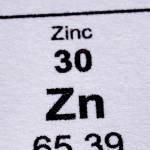Trace Minerals for Horses: Zinc and Copper

A great deal of attention has been given to the requirements of broodmares and young horses for copper and zinc. The role of copper in the copper-dependent enzyme lysyl oxidase and that enzyme’s role in the formation and maturation of cartilage has obviously stimulated interest in copper as it relates to developmental orthopedic disease in young horses. Additionally, zinc has long been known to play a role in the maintenance of epithelial integrity and keratogenesis. The use of copper and zinc supplementation in modern horse feeds for all classes of horses stems from the possible role of these two nutrients in reducing physitis, osteochondrosis, wobbler syndrome, and other manifestations of developmental orthopedic disease.
It is interesting to note that in addition to its role in cartilage and bone metabolism, copper is involved in hemoglobin formation and in nerve conductivity and coordination. Copper is also involved in other enzymes such as tyrosinase and cytochrome oxidase to name but a few of the more well known of the enzymes containing a copper moiety or which need copper as a co-factor. There is a small loss of copper in the sweat of horses that may result in sweat losses of 80-100 mg of copper per day.
Zinc is involved as a co-factor in a multitude of enzyme systems. Alcohol dehydrogenase, carbonic anhydrase, and carboxypeptidase are but a few of the zinc-requiring enzymes. In addition to the role as enzyme activator/cofactor, there are in excess of 200 zinc-containing proteins. Of zinc stored in the body, 50 to 60% is in muscle tissue.
Zinc deficiency has resulted in reduced insulin levels and reduced glucose tolerance along with increased insulin resistance especially in the peripheral tissues. There has been a noted decrease in glucose utilization in zinc-deficient animals with a concomitant increase in fat catabolism. In terms of bone metabolism, zinc deficiency directly inhibits the effectiveness of somatomedin in stimulating cartilage growth, and the classical symptom of zinc deficiency is disrupted keratogenesis.
A significant amount of zinc—about 20-21 mg/l—is lost in sweat. In the hard-working horse, this zinc loss can be substantial. High levels of calcium and copper can reduce zinc absorption, so the kind of hay being fed may have an impact on the amount of zinc required by the horse. Increased levels of protein or increased protein intake have been shown to reduce zinc absorption and increase zinc excretion. These classic and well-documented physiological and biochemical functions of zinc along with the relatively high zinc losses in the sweat have resulted in the development of more liberal allowances for zinc for performance horses.
When the efficacy of hoof supplements is considered, the inclusion of zinc methionine along with biotin and 3 grams of methionine appears to result in greater growth of the stratum germinativum and the tubular horn of the hoof wall than does the feeding of biotin alone.








